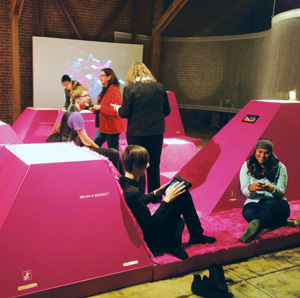With “innovation” already an overused, puffed-up buzzword, it feels good to see ZERO1 introduce an artist fellowship program into the mix. I get especially confident when I read stuff like this: “A platform for artistic experimentation that recognizes the artist as the ultimate provocateur, risk-taker and source of innovation.”
Since the challenges of an increasingly uncertain world demand new creative strategies, the – Garage is now partnering with the Adobe Creative Technologies Lab, the Christensen Fund and Google, each of which will sponsor a particular artist’s project over the course of this year.
In each case, the project will be a collaboration, a process and/or a dialog. The circuitry connecting all of the component parts is just as important as the parts themselves. Everything is connected, with the Garage functioning as part think tank, part gallery, part psychological incubator, part policy implementer and part metaphorical server room.
It sounds like snoozy academic-speak, but this is actually a pretty radical idea. Artists are the ones running the ZERO1 Garage, which is precisely what sets it apart from the shallow “innovation” talk currently boring audiences worldwide. The Garage philosophy is that if anyone in the high-tech universe really wants to solve social and cultural problems and make the world a better place, artists need to be in the conversation, since they are the true radical experimenters and the ones most comfortable with uncertainty. It’s how they intrinsically operate.
At the launch event last week, ZERO1 Garage executive director Joel Slayton articulated a vision to graft artistic creativity onto any collaboration, in any context, as a vehicle for inventing a better future landscape. Each year from now on, the Garage, along with its sponsoring partners, will define particular problems requiring radically new creative approaches and then select a number of artists to implement those approaches. The artists receive a stipend and work together with the sponsors and each other. Everything and everyone will be connected.
“Imagine what this might look like in five years,” Slayton said from the podium. “We’ll have a very robust network of thought leaders, practitioners and creatives, from a variety of interdisciplinary fields, so that when we use this term ‘artists’ we’re talking about artist-technologist, artist-entrepreneur, artist-designer, artist-architect, artist-urban-planner, really, this new generation of creatives that are shaping the world. And we want the Garage to be the centerpiece in Silicon Valley where those experiments come to life.”
The inaugural three ZERO1 Fellows, all three of whom are Bay Area women, then presented their prospective projects. Paula Levine, a Canadian-American artist who teaches at San Francisco State University and is supported by Google, discussed the concept of empathy in a digitally connected global world: that is, mapping everybody else’s suffering onto your own situation as a vehicle for understanding. The idea stemmed from her previous work, which included grafting a map of the U.S. invasion of Baghdad onto a map of San Francisco.
Cecilia Galiena, originally from Rome, presented a more mystical approach, claiming that artists provide a fresh, alternative method of inquiry, a perspective beyond the linear, objective method of science. An artist is inseparable from the audience, she said.
Initially, Galiena will focus on how indigenous peoples, through their stories and cultures, are seeking to make intellectual property serve a function besides value appropriation. Her fellowship is thanks to the Christensen Fund, a philanthropic organization integrating the arts, biodiversity and education.
The Adobe Creative Technologies Lab (CTL) kicked in for the third artist, Daniela Steinsapir, who is now given the task of developing new approaches for cross-generational collaborative communication platforms, which could include storytelling across geographical and generational boundaries, touch-screen photo editing, language translation and other developments.
Which poses one final question: Where does art criticism function in all of this? As creative paradigms continue to evolve, so must the apparatus of critique. That is an issue no one seems willing to address yet. I predict a whole new meaning for the term Garage Critic. Get ready.




